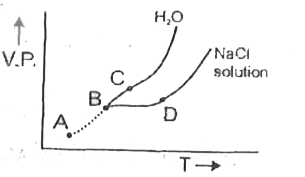The freezing point of equimolal solution will be highest for :
C6H5NH3Cl
Ca(NO3)2
La(NO3)2
C6H12O6
The correct Answer is:d
To solve the question regarding which equimolar solution has the highest freezing point, we can follow these steps:
Step 1: Understand the Freezing Point Depression
The freezing point depression (ΔTf) is given by the formula:
ΔTf=Kf⋅i⋅m
Where:
- Kf is the cryoscopic constant (depends on the solvent),
- i is the van 't Hoff factor (number of particles the solute dissociates into),
- m is the molality of the solution.
Step 2: Relate Freezing Point to Depression
The freezing point of the solution (Tf) is related to the freezing point of the pure solvent (Tf,pure) by:
Tf=Tf,pure−ΔTf
This means that as ΔTf increases (due to a higher i), the freezing point of the solution decreases.
Step 3: Analyze the Given Solutions
We need to determine the van 't Hoff factor (i) for each of the given solutes:
1. C6H5NH3Cl (Aniline hydrochloride):
- Dissociates into: C6H5NH3++Cl−
- i=2
2. Ca(NO3)2 (Calcium nitrate):
- Dissociates into: Ca2++2NO3−
- i=3
3. La(NO3)3 (Lanthanum nitrate):
- Dissociates into: La3++3NO3−
- i=4
4. C6H12O6 (Glucose):
- Does not dissociate (non-electrolyte).
- i=1
Step 4: Compare the Values of i
From the calculations:
- i for C6H5NH3Cl = 2
- i for Ca(NO3)2 = 3
- i for La(NO3)3 = 4
- i for C6H12O6 = 1
Step 5: Determine the Highest Freezing Point
Since the freezing point decreases with an increase in i, the solution with the lowest i will have the highest freezing point. Here, glucose has the lowest i=1.
Conclusion
Thus, the freezing point of the equimolar solution will be highest for C6H12O6 (glucose).
---
The freezing point depression (ΔTf) is given by the formula:
ΔTf=Kf⋅i⋅m
Where:
- Kf is the cryoscopic constant (depends on the solvent),
- i is the van 't Hoff factor (number of particles the solute dissociates into),
- m is the molality of the solution.
The freezing point of the solution (Tf) is related to the freezing point of the pure solvent (Tf,pure) by:
Tf=Tf,pure−ΔTf
This means that as ΔTf increases (due to a higher i), the freezing point of the solution decreases.
We need to determine the van 't Hoff factor (i) for each of the given solutes:
- Dissociates into: C6H5NH3++Cl−
- i=2
- Dissociates into: Ca2++2NO3−
- i=3
- Dissociates into: La3++3NO3−
- i=4
- Does not dissociate (non-electrolyte).
- i=1
From the calculations:
- i for C6H5NH3Cl = 2
- i for Ca(NO3)2 = 3
- i for La(NO3)3 = 4
- i for C6H12O6 = 1
Since the freezing point decreases with an increase in i, the solution with the lowest i will have the highest freezing point. Here, glucose has the lowest i=1.
Thus, the freezing point of the equimolar solution will be highest for C6H12O6 (glucose).
Topper's Solved these Questions
- DILUTE SOLUTIONBOOK - NARENDRA AWASTHI ENGLISHCHAPTER - DILUTE SOLUTIONEXERCISE - leval-02
26 Videos
- DILUTE SOLUTIONBOOK - NARENDRA AWASTHI ENGLISHCHAPTER - DILUTE SOLUTIONEXERCISE - leval-03
23 Videos
- CHEMICAL EQUILIBRIUMBOOK - NARENDRA AWASTHI ENGLISHCHAPTER - CHEMICAL EQUILIBRIUMEXERCISE - Match the column
1 Videos
- ELECTROCHEMISTRYBOOK - NARENDRA AWASTHI ENGLISHCHAPTER - ELECTROCHEMISTRYEXERCISE - Subjective problems
14 Videos
Similar Questions
Knowledge Check
The lowest freezing point of 0.1 M aqueous solution is of:
AK2SO4BNaClCUreaDGlucose
At freezing point of a solution there is always
View SolutionThe freezing point of 4% aqueous solution of 'A' is equal to the freezing point 10% aqueous solution of 'B'. If the molecular mass of 'A' is 60, then the molecular mass of 'B' will be:
View SolutionThe freezing point of water is depressed by 0.37∘C in a 0.01 molar NaCI solution. The freezing point of 0.02 molar solution is depressed by
View SolutionThe freezing point of a 1.00m aqueous solution of HF is found to be −1.91∘C. The freezing point constant of water, Kf, is 1.86Kkgmol−1. The percentage dissociation of HF at this concentration is:-
View SolutionSTATEMENT-1 : The frezing point of 0.05M urea solution is different from that of 0.05M sodium chloride solution.
STATEMENT-2 : The dpression in freezing point is directly proportional to the number of species present in the solution.
View SolutionThe freezing point of a 0.05 molal solution of a non-electrolyte in water is:
(Kf=1.86molality−1)
View SolutionThe freezing point of 1% aqueous solution of calcuim nitrate will be
View Solution

